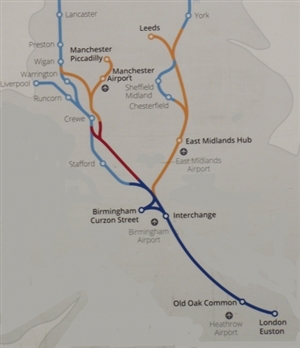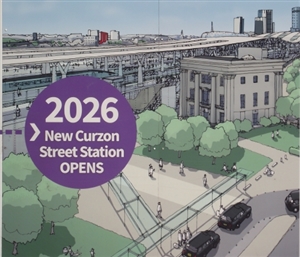Tanya Galliara, in a joint event with INCOSE UK, set out to describe some aspects of requirements management for a large civil engineering project, in particular as they relate to N1 and N2 (Northern) packages of HS2 (High-Speed railway, number two). HS2 is currently the UK's largest civil engineering project. Phase One will connect London to Birmingham and is expected to be completed in 2026, Phase Two will connect Birmingham to Leeds and is expected to be completed in 2033.
It was explained that High Speed Two (HS2) Limited (HS2L) is responsible for developing and promoting the UK's second high-speed railway which will be built in several 'phases'. The development, design and construction of each phase will proceed through various 'stages' and within those stages certain approval 'gates' must be satisfied before the project can proceed. Thus Phase 1, Gate 5 gives approval to proceed on to Phase 2, the detailed design for construction.
Before approval can be given it is necessary to provide evidence that all of the requirements have been met. To facilitate that the requirements management of Phase 1 work packages N1 and N2 (geographical zones 1) has been contracted to Balfour Beatty VINCI (BBV). As part of this work BBV made an initial assessment of all of the infrastructure assets within the work packages, identifying those with high risk (T1), potential for large savings (T2) and multiple or similar examples (T3). The assets could be classified as, for example, viaducts, overbridges, underbridges, culverts etc. In all 176 assets were identified of which 14 were given priority following the T1-3 review.
For each of these assets there are Environmental Minimum Requirements and various stakeholders, requiring the management of interfaces with, say, Network Rail or the Highways Agency. The demands of the construction schedule and the impact on the approval process also need to be managed. The DOORS requirements management tool is currently being used, with eight 'floating' licences, (i.e. up to 8 concurrent users). It is planned to migrate to DOORS NG a web/'cloud'-based solution, giving greater opportunities to share data and move to more Model-based Systems Engineering (MBSE).
DOORS provides a unique identifiers for requirements, stakeholders and interfaces. It tracks changes and facilitates defining baselines and supports import and export of Microsoft Word/Excel files. These MBSE tools allow a more visual as opposed to text-based methods of tracking progress, allowing the creation of 'dashboards' to access data and map-like reports that clearly show the various dependencies and, by simple colour ('traffic light') codes. In addition it can be linked with HS2L systems, allowing the re-definition of requirements where necessary, and links to the Building Information Management Systems (BIMS). It was thought that engineers in generally preferred graphical methods and map reports were appreciated by non-engineering stakeholders, e.g. wild life trusts, helping them to understand the various factors that the project depended on.
During the questions it became clear that the systems engineering approach was relatively new to civil engineering and produced many benefits, giving the chance to change design decisions and boundaries.
For anyone who has not been involved in a large publicly-funded project this talk gave an insight into the many approval hurdles that have to be surmounted both before and after detailed design work has commenced. Civil engineering projects often differ from other projects in that they are with few exceptions bespoke solutions and can involve many stakeholders, not all of whom have been identified at project conception. It was interesting how the requirements and risks were managed and communicated to all stakeholders, with some discussion as how best present the information.
No doubt there is a lot of merit in these methods but I can't help but feel that the data collected expands to fill the capacity of the information system that manages it! I am reminded of a colleague who kept a copy of every email that he had sent and received. He explained that this enabled him to back up his claims to have requested something two years earlier that wasn't now being done. While that gave him a good feeling it didn't actually get done that which hadn't been done, i.e. it provides plenty of meal for the lawyers mill. However as engineers one of our objectives is not having to allocate blame. As ever there is a balance to be made here.
Incidentally one questioner asked what had happened to the Carillion staff following its demise. It was suggested that most would have been taken on by other contractors. Apparently in August 2018, Mark Davies, former boss of Carillion's UK infrastructure business was appointed as managing director of BBV!
Notes:
1. HS2 Phase One (North) works packages:
N1: Long Itchington Wood Tunnel to Delta Junction (i.e. south of Birmingham)
N2: Delta Junction to WCML (West Coast Main Line) tie-in ( i.e. north of Birmingham)
N3: Birmingham Interchange Station (North-South through-line station)
N4: Birmingham Curzon Street station (Birmingham spur terminus)
(HS2 through-line passes to east of Birmingham with a delta (three-way) junction to Curzon Street (central Birmingham) station spur.
Links
INCOSE UK International Council on Systems Engineering
HS2L – High Speed Two Limited (home page)
DOORS – Overview of Rational DOORS (IBM requirements management tool)
MBSE – Model-based Systems Engineering (Wikipedia)
BIM – What Is Building Information Modelling? (Engineering.com article)
Building Information Modelling: an IET event held in Bath November 2015
Pre-Event Publicity (Information that often gets lost post-event):
High Speed 2 (HSE) Phase 1 Major Works Civils Construction (MWCC) follows the typical form of a Large Infrastructure Project (LIP) by consisting of two main stages; the development of an engineering solution in the form of a detailed design and, the delivery of the design solution through procuring contractors to build or construct the solution. These types of projects face their own challenges in the implementation of Systems Engineering, specifically, good Requirements Management. Since HS2 Phase 1 received Assent in early 2017, a few interesting challenges have already been faced in implementing appropriate requirements management. Many projects face similar issues, with teams going ahead into delivery before thinking clearly about requirements.
In the case of a Rail industry project such as HS2, it is not always possible to develop or test a prototype. The challenge faced by the MWCC work is that this phase of works is setting the foundation for not only successful delivery of HS2 Phase 1 but also the future successes of HS2 Phases 2a and 2b. The design is, to a large extent, circumscribed by standards and codes. The technical solutions will be based on those of recent projects, are also being challenged to be innovative, future proof and to deliver value for money. Due to these factors, the design processes for HS2 MWCC will be based on relatively well established and reasonably optimized processes currently used by industry. The complexity to be addressed lies more in issues of interfaces, procurement and constructability, given the specific political, commercial and local conditions, than in the design of a certain type of bridge or the particular alignment of a railway.
Specific challenges that need to be addressed in developing an appropriate Requirements Management Process include:
- The Contracting Strategy being used by HS2, particularly its impact on the management of interfaces between different system.
- The Organisational breakdown of the suppliers (for example, delivery of the different packages) and the impact of this on a Requirements Management Strategy.
- Ensuring of clarity around handover at the completion of different stages such as MWCC, and across the different geographical packages
- Enforcing the requirements hierarchy and enabling the appropriate decomposition and V&V to be developed to ensure successful delivery - Balfour Beatty Vinci (BBV) will have to develop a strategy for ensuring that the requirements for N1 and N2 packages are correctly derived and communicated to its supply chain.
The number of stakeholders and consequent number of requirements in a LIP such as HS2 mean that the consequences of inadequately managed requirements could include: contractual and regulatory commitments being overlooked, requirements not flowing down to subcontractors or suppliers and are incomplete, unclear, not regularly updated, and subject to widely varying interpretations. This could lead to the supplier (BBV) having have difficulty in demonstrating requirements were met. Therefore, making the time to develop a requirements management strategy will allow a greater understanding of the responsibility for who is managing and how to manage the requirements.
Solving these and other issues drive the need for a more formal approach to managing requirements. Such a strategy will need to cover various topics, which will include: identifying and documenting why the end product or system needs to exist in terms of value provided to the end user; gaining Client and Stakeholder agreement on the written statements and on the measures of successful completion; ensuring that regulatory requirements are understood by all parties.
This will allow BBV to explicitly show how the proposed designs are directly traceable to providing the system’s value within constraints (e.g., cost, regulatory, and social constraints) and to continue derivation and decomposition such that derived requirements can be allocated to system and components. Another aspect that BBV will have to consider is the implantation of a change control process for requirements that will facilitate change through a prescribed process and appropriate levels of authority, and to ensure that approved changes are propagated to all affected items. A way to manage this will be through the development of a baseline, that is, a configuration controlled set of approved and correctly allocated requirements which are established sequentially and used to control change and reduce risk. This will form the basis for integrated Verification and Validation (V&V) planning and successful delivery of HS2 Phase 1 MWCC.
Implementation of a successful Requirements Management Strategy will enable BBV to show to HS2 that it has correctly understood what is needed to deliver HS2 MWCC. The exercise is more than just a paper ticking exercise. By showing our client that we have understood what is important to them, that we have understood the constraints and issues that are important, will we be able to engage with them to develop innovate design and construction solutions for a project which is heavily in the public eye. Successful delivery will help facilitate the longer term development of HS2 and future extension programmes, and enable BBV to demonstrate their capability in this market sector.

